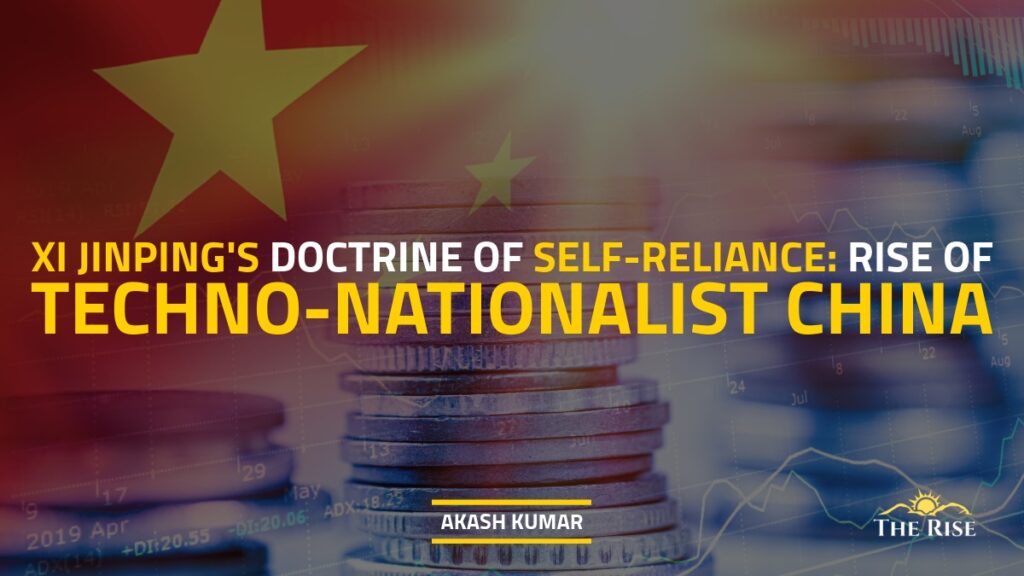Doctrine of Self-Reliance is the unifying theory of Xi Jinping’s rule that has systematically and deliberately forged a techno-nationalist China. By elevating Science, technology, and innovation from an economic tool to the primary determinant of national security and identity, Xi has set his nation on an irreversible course. By authoring the global rules for 5G, the Internet of Things, and AI, Chinese technology today is not just an option, but has become the default global standard.
“Science has no borders, but scientists have a motherland.” This statement, frequently invoked by Xi Jinping, transcends mere patriotic sentiment. It serves as the foundational creed for a coherent and formidable strategic framework that can be defined as the “Doctrine of Self-Reliance.”
Under Xi’s leadership, this doctrine has strategically merged Science, Technology, and Innovation (STI) with the core tenets of national security, industrial strategy, and geopolitical ambition. It has become the ideological engine driving the People’s Republic of China, transforming it from an economic powerhouse into a techno-nationalist superstate. Here, technological prowess is not merely a tool of governance but the core measure of power and identity. Born of historical ambition and geopolitical urgency—and executed through an autocratic technocratic system—this doctrine now stands as the central force behind China’s rapid rise in critical technologies and its challenge to the global order.
The formal canonisation of this doctrine occurred at the 20th Party Congress in 2022, a moment of profound ideological significance. In his work report, Xi Jinping elevated Science, Technology, and Innovation to an unprecedented position, dedicating an entire section to “Invigorating China Through Science and Education” and placing it strategically ahead of traditional economic policy. He designated innovation as the “primary driving force” and talent as the “primary resource” for the “great rejuvenation of the Chinese nation.”
This was a deliberate and stark departure from the Deng Xiaoping era’s formulation, which posited that science and technology were a “primary productive force“—a phrase that framed innovation as a critical input for economic growth. Xi’s rearticulation elevated this idea to something far more fundamental: casting technology as the very engine of national destiny and survival. It was no longer just about getting rich; it was about becoming powerful and, crucially, invulnerable.
Also Read: BRICS in Transition: Expansion, De-Dollarization, and the Growing Role of the New Development Bank
This shift did not occur in a vacuum. It is the culmination of Xi’s long-held belief that technological dependency is China’s Achilles’ heel in an increasingly hostile world. The doctrine’s ultimate goal is to achieve what Chinese strategic documents refer to as being “independently controllable” (zìzhǔ kěkòng), which is a state of comprehensive technological sovereignty. When a nation’s ability to innovate is tied directly to its capacity to withstand external pressure and secure its future, technology ceases to be merely economic; rather, it becomes a pillar of national pride, a focal point of state propaganda, and a core component of state identity. This is the very definition of techno-nationalism, and it is the ideological destination to which Xi Jinping’s vision has deliberately guided China.
The successful implementation of such a grand, systematic doctrine is inseparable from a unique and often-overlooked characteristic of China’s modern leadership: its deep technocratic roots. The thrust of this scientific temper flows directly from the apex of power because the supreme leaders themselves have been, by training, engineers. Xi Jinping is a chemical engineer from the elite Tsinghua University. His predecessors, Jiang Zemin and Hu Jintao, were trained in electrical engineering and hydraulic engineering, respectively. The premiers who managed the intricate machinery of the state, Zhu Rongji and Wen Jiabao, were an electrical engineer and a geological engineer. In a centralised, autocratic system where decision-making is absolute and emanates from the top, this shared background is a profound policy-shaping force. These leaders are predisposed to view the state as the ultimate engineering project, a complex system to be diagnosed, blueprinted, and optimised for long-term strategic goals.
Also Read: Trump’s America First Doctrine: Rethinking U.S. Alliances, Power, and Global Strategy
This engineering-driven mindset found its most potent expression in a series of ambitious national strategies that serve as operational blueprints for the Doctrine of Self-Reliance. The first was Made in China 2025, a vast national engineering specification designed to overcome critical deficiencies and build domestic champions. It identified ten key sectors, including AI, new energy vehicles (EVs), and advanced robotics, and set aggressive, measurable targets for domestic content and market share. This state-directed, blueprint-driven approach is directly responsible for China’s current virtual hegemony in critical industries. It fuelled the rise of global giants like BYD in Electric Vehicles and CATL in batteries, and solidified China’s unshakeable dominance in the processing of Rare Earth Elements, the foundational materials of modern technology.
If MIC 2025 was about engineering the hardware of self-reliance, China Standards 2035 is the more sophisticated plan to write its global operating system. The technocratic logic is clear: once you master the manufacturing of a product, the next and ultimate phase of dominance is to define the international technical standards upon which that product and all its competitors must operate. By authoring the global rules for 5G, the Internet of Things, and AI, Beijing aims to lock in its technological advantages, creating an ecosystem where Chinese technology is not just an option, but the default global standard. This is the doctrine’s most audacious play, transforming a national industrial policy into a bid for global technological leadership.
The geopolitical climate acted as a powerful accelerant, turning this long-term strategy into a national emergency. The US-China trade war, escalating under successive administrations into a full-blown tech war, and culminating in the CHIPS and Science Act, was a “Sputnik moment” for Beijing. These actions, especially the severe restrictions on semiconductor exports, validated Xi’s deepest fears of the “chokehold” (kǎbózi), a term that pervades Chinese strategic discourse and signifies an existential technological vulnerability.
Xi’s response was not a diplomatic negotiation but a structural re-engineering of the state’s innovation apparatus. He activated and massively resourced the “new national system”, a twenty-first-century mobilisation model designed to solve critical, “chokehold” problems. It is the doctrine’s crisis-response protocol, marshalling the full might of the state, its national labs, universities, state-owned enterprises, and private “national champions” like Huawei to achieve a singular, strategic breakthrough, such as building a secure and “independently controllable” domestic semiconductor industry.
The vanguard of this doctrine is most visible in China’s stunning advances in the disruptive technologies of the future. In Artificial Intelligence, state policy has cultivated a formidable ecosystem. While claims of China possessing “half the global AI talent” are debatable, the underlying reality is a massive, state-cultivated pipeline of engineers, supported by unparalleled access to data and driven by state-led application in everything from smart cities to national security.
In Quantum Technologies, the doctrine’s long-term vision is clearest. Viewing it as a technology that could render all current encryption obsolete, the state has poured billions into large-scale “megaprojects.” This resulted in world-leading achievements like the “Micius” satellite, the first platform for unhackable space-to-ground quantum communication, and a prime example of the “new national system” driving a strategic leap over the West.
In conclusion, the Doctrine of Self-Reliance is the unifying theory of Xi Jinping’s rule. It is a comprehensive worldview that has systematically and deliberately forged a techno-nationalist China. By elevating STI from an economic tool to the primary determinant of national security and identity, and executing this vision through an autocratic system guided by a deep-seated technocratic ethos, Xi has set his nation on an irreversible course. Global competition is no longer merely economic; it is a fundamental clash of systems and ideologies driven by a doctrine that sees the future of a nation and, indeed, the world as being written in lines of code and etched in silicon.
Disclaimer: The views expressed in this article are those of the author solely. TheRise.co.in neither endorses nor is responsible for them. Reproducing this content without permission is prohibited.
About the author
Akash Kumar is researcher working at the intersection of Science Technology and International Relations with a focus on critical and emerging technology. He is currently pursuing his PhD in Science Policy Studies from School of Social Sciences, Jawaharlal Nehru University working on India's semiconductor diplomacy.









